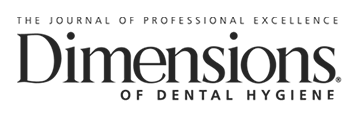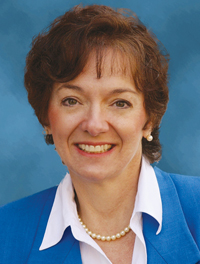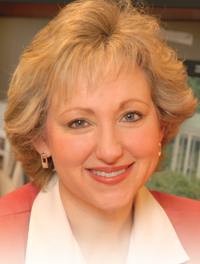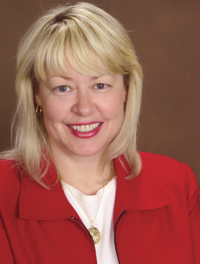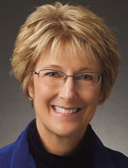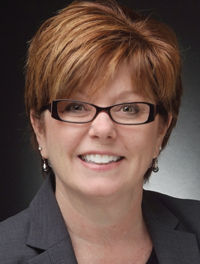 With more than 20 years of service to the University of Missouri-Kansas City School of Dentistry, Cynthia C. Gadbury-Amyot, MSDH, EdD, is the associate dean of instructional technology and faculty development and a professor in the Division of Dental Hygiene. Experienced in a variety of academic roles—from interim associate vice provost of online education to director of graduate and degree completion studies—Gadbury-Amyot teaches at all levels of the curriculum. She has also contributed extensively to the scientific literature. Dedicated to improving access to care, Gadbury-Amyot has been actively involved in the Miles of Smiles program, a school-based dental home that provides services on-site with mobile equipment. She is also a member of Dimensions of Dental Hygiene’s Editorial Advisory Board.
With more than 20 years of service to the University of Missouri-Kansas City School of Dentistry, Cynthia C. Gadbury-Amyot, MSDH, EdD, is the associate dean of instructional technology and faculty development and a professor in the Division of Dental Hygiene. Experienced in a variety of academic roles—from interim associate vice provost of online education to director of graduate and degree completion studies—Gadbury-Amyot teaches at all levels of the curriculum. She has also contributed extensively to the scientific literature. Dedicated to improving access to care, Gadbury-Amyot has been actively involved in the Miles of Smiles program, a school-based dental home that provides services on-site with mobile equipment. She is also a member of Dimensions of Dental Hygiene’s Editorial Advisory Board.
After working in private practice for many years, what motivated you to move into academia?
I graduated with an associate degree in dental hygiene and always knew that I wanted to further my education. When I returned to school to seek a bachelor’s degree 13 years later, I wasn’t thinking of entering academia. As I worked to complete my bachelor’s degree, I was encouraged by faculty at the University of Missouri-Kansas City to continue with my studies, and before I knew it I was in the master’s program. These faculty mentors saw something in me that I didn’t see in myself—a future educator.
What were some of the challenges you faced in returning to school?
At the time, my children were 7 and 10. The addition of school to this dynamic required a good deal of juggling to ensure that I could devote adequate time to my studies, stay on top of my children’s activities, and run a household with my husband who was also busy in his career. Learning how to organize and prioritize my academic workload was interesting at first. As I have told students through the years who have children, in hindsight I was “modeling” for my children what being a student was all about—I was confident they were doing the same. We moms do the guilt thing so readily, and I hope I have been able to provide some comfort to nontraditional students in this regard.
What are some of your responsibilities as associate dean of instructional technology and faculty development?
No two days are alike in this position. One day I may be working with a group of faculty on the methodology behind using an audience response system to foster active learning, while the next I may be using the technology in the classroom. Another day I might be helping a faculty member revise his or her course and consider how we can collect data to ultimately publish the results. I chair the Faculty Development Committee, which is responsible for organizing educational sessions at the School of Dentistry. On average, our development opportunities result in more than 50 continuing education units for our faculty each year. We use internal expertise, as well as bring in national experts to work with our faculty on the latest science in dentistry and dental education. I remain very active in the Division of Dental Hygiene by helping graduate students with their research projects. I also maintain my own research agenda, so some days my efforts go toward writing literature reviews and research proposals, conducting the actual research, analyzing and synthesizing the data, and preparing a manuscript for submission.
What are some of the changes that need to happen in dental hygiene education to ensure that the workforce is well prepared for the expanding career options available to dental hygienists?
We work in a different world today compared to when I graduated in 1976. Today’s environment demands that individuals possess digital literacy skills. I believe dental hygiene education has been successful at adopting technology into the teaching and learning models for our students, and it is critical that we continue to do more in this arena. I think what we need to do better is help our students imagine the possibilities in the workforce based on their knowledge and skills. Dental hygienists have more opportunities today than ever before with the changing health care environment, but we must help students reach out and grab them. As professionals, we can’t wait for jobs to come to us. We must be proactive and convince organizations and institutions of our value and why they should hire dental hygienists.
What obstacles did you encounter as you began teaching?
My challenges were typical. It takes time to become a content expert, and I was scrambling to stay a few steps ahead of my students in my first few years of teaching. In fact, I have apologized to students from my early teaching career because I know I wasn’t capable of giving them an “expert” experience in the classroom. Teaching clinic was different, however, because I had practiced clinically for many years before entering academia. I had solid experience to offer in clinical teaching—based on the science presented in the classroom and my hands-on knowledge of clinical practice.
What do you love most about working in academia?
I am energized by the independence and creativity that are central to education! I love that I can bring an idea to the faculty—such as putting our degree completion and graduate programs online—and have colleagues get behind it. I feel very fortunate to work among colleagues and administrative staff who foster my creativity and innovation.
